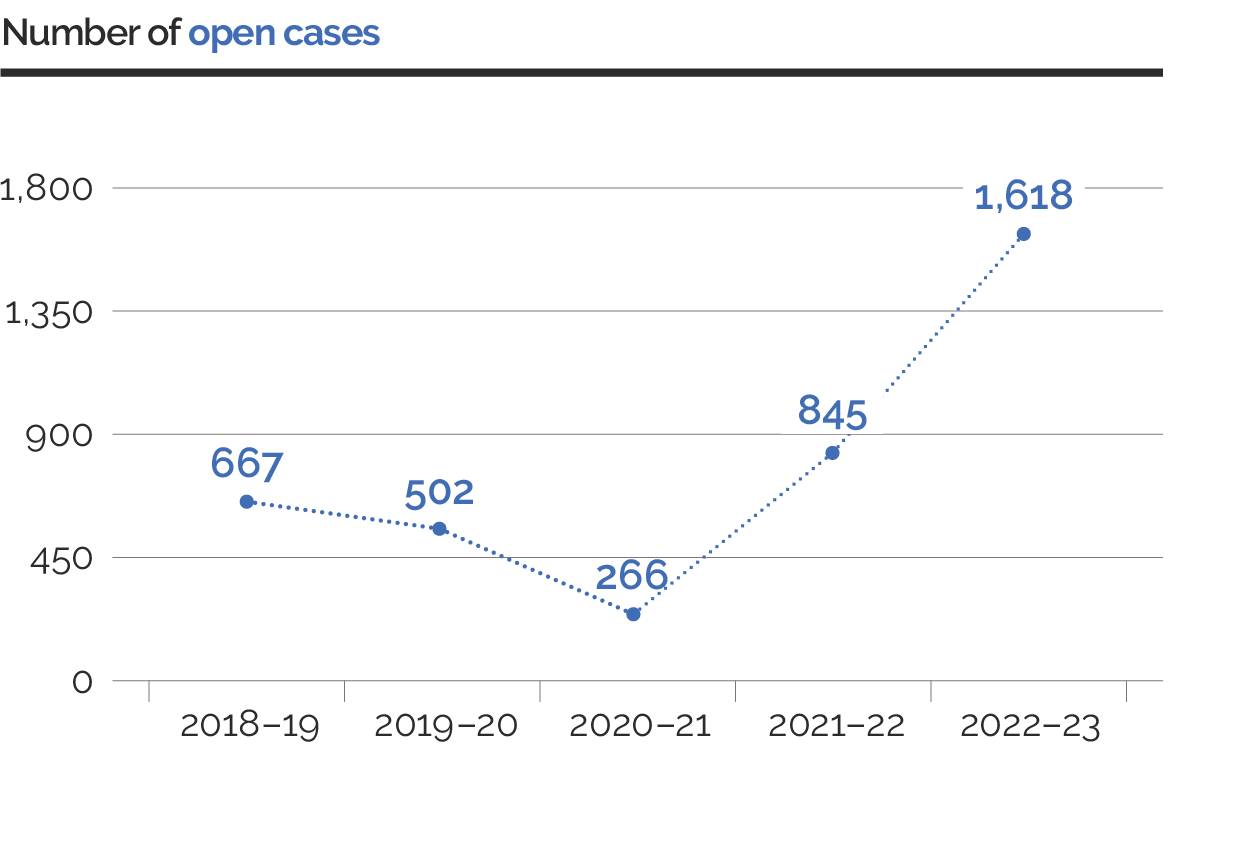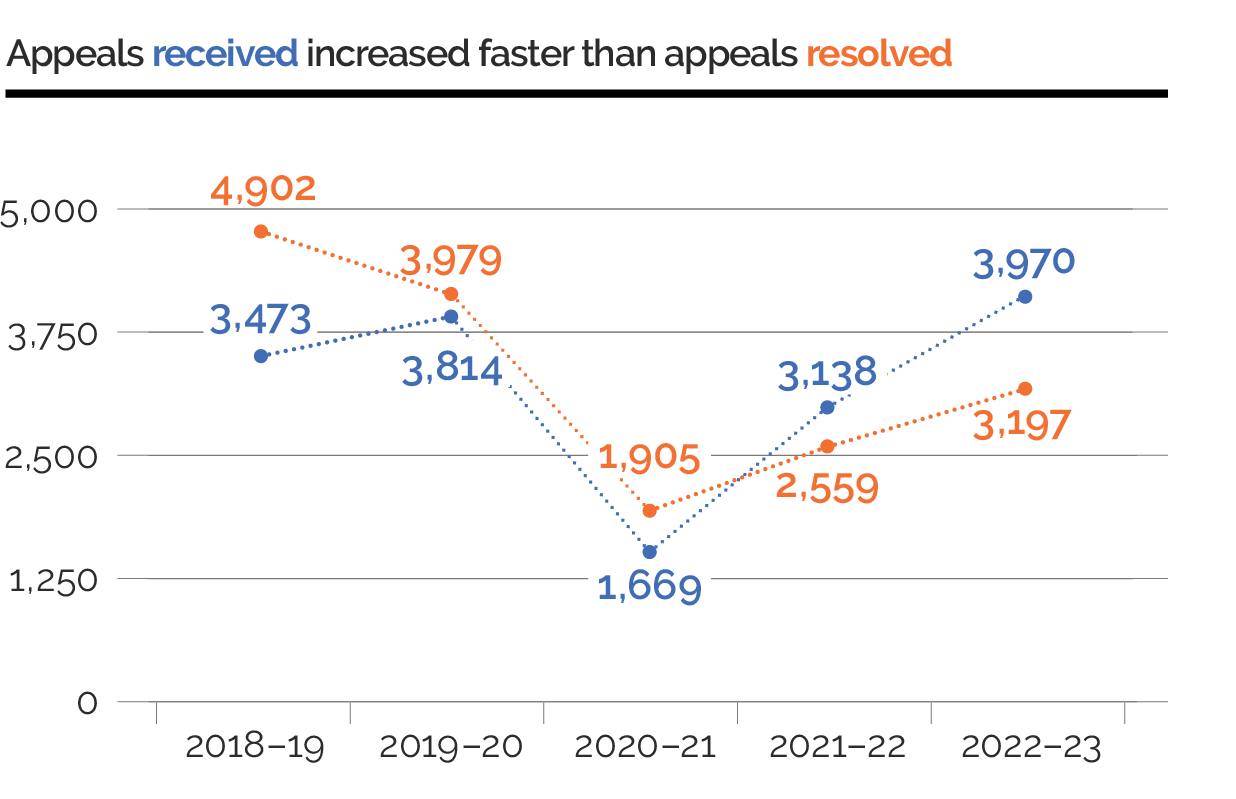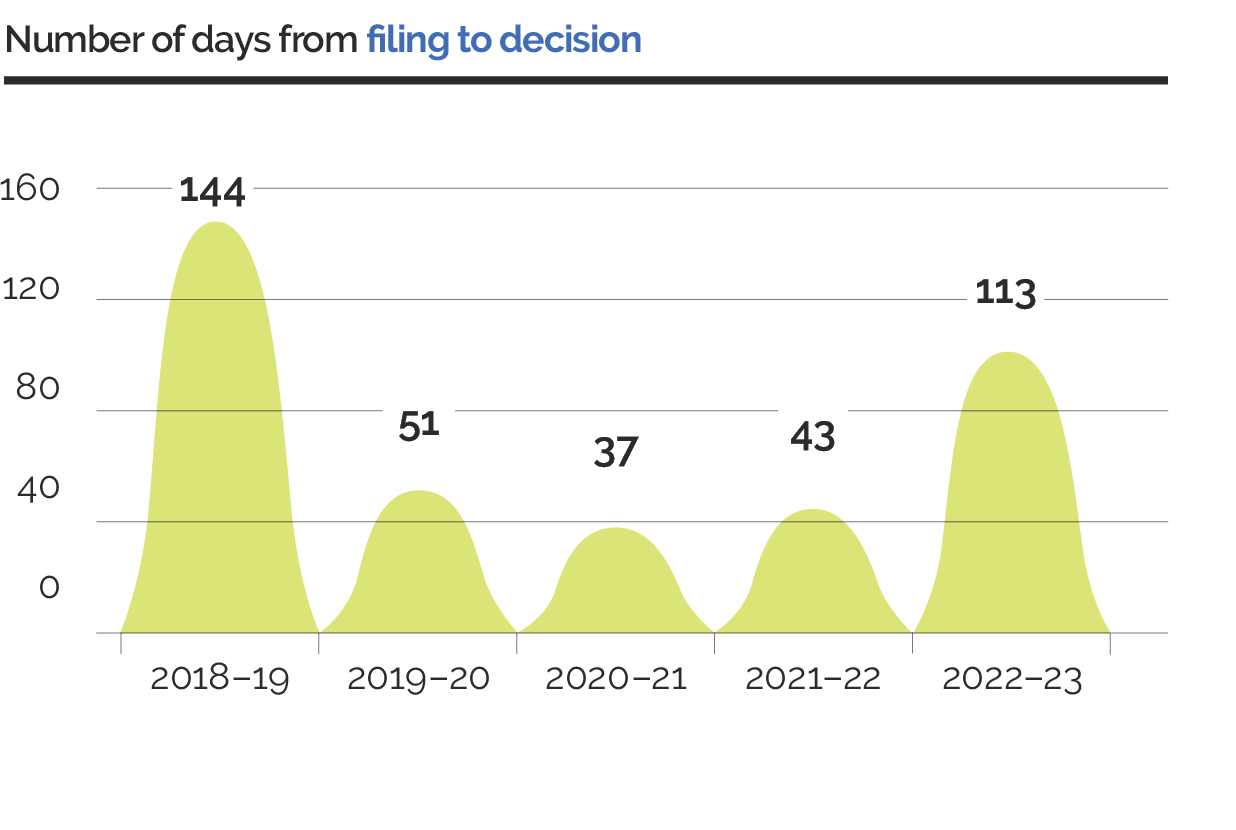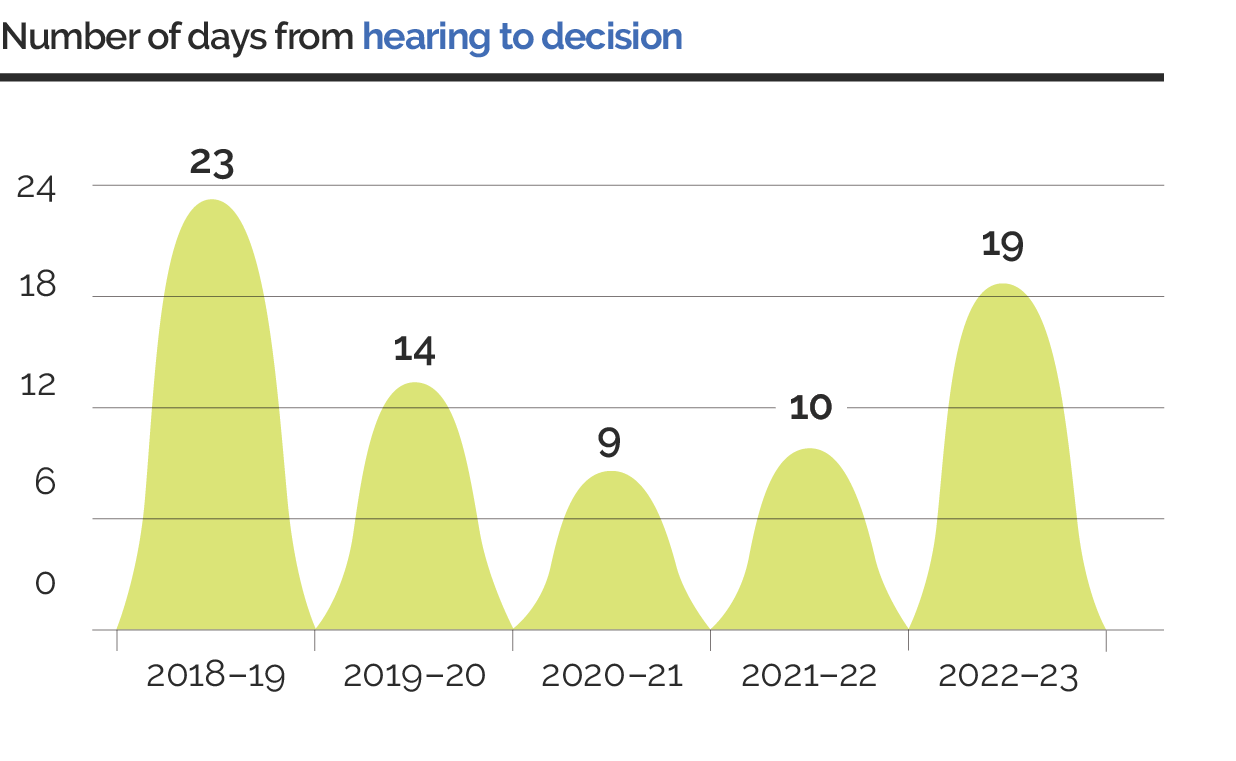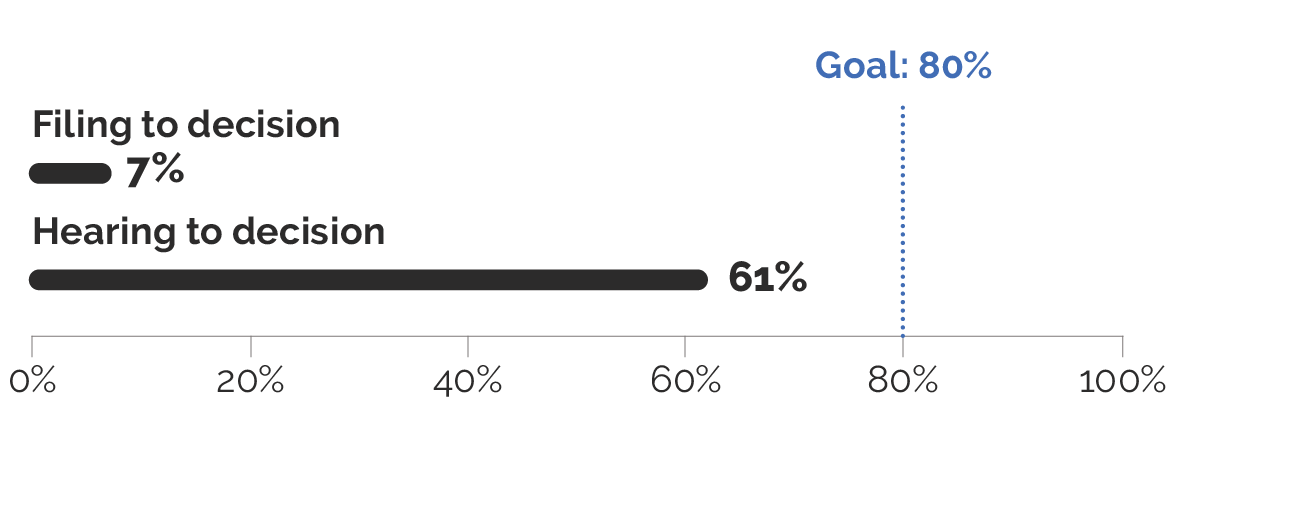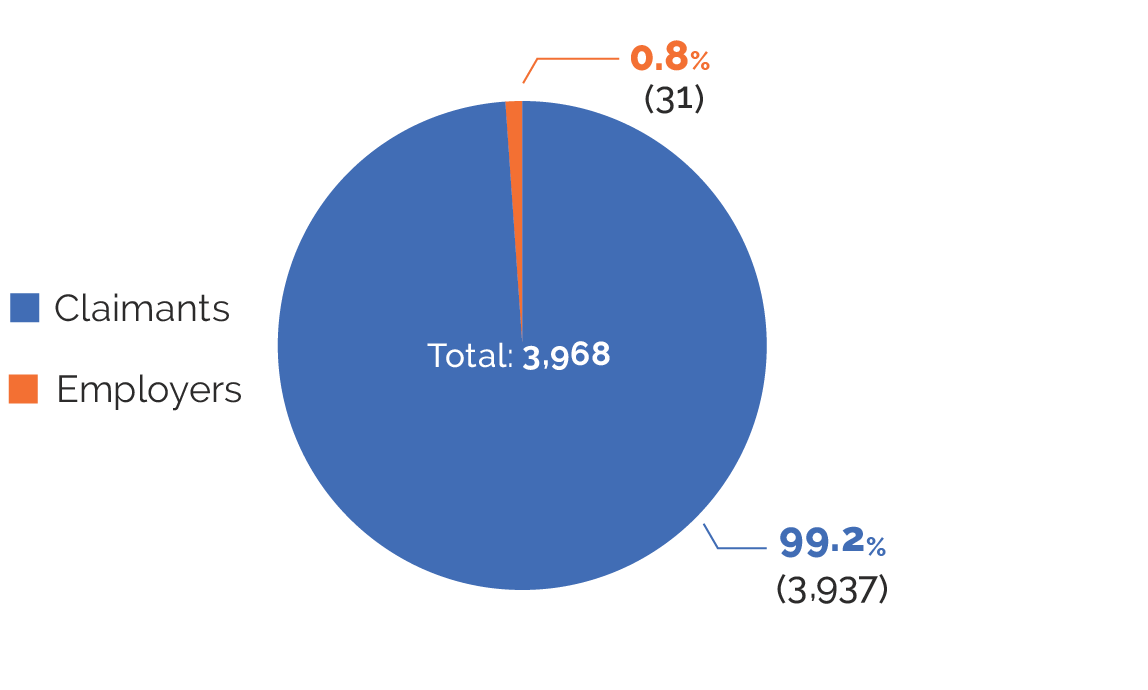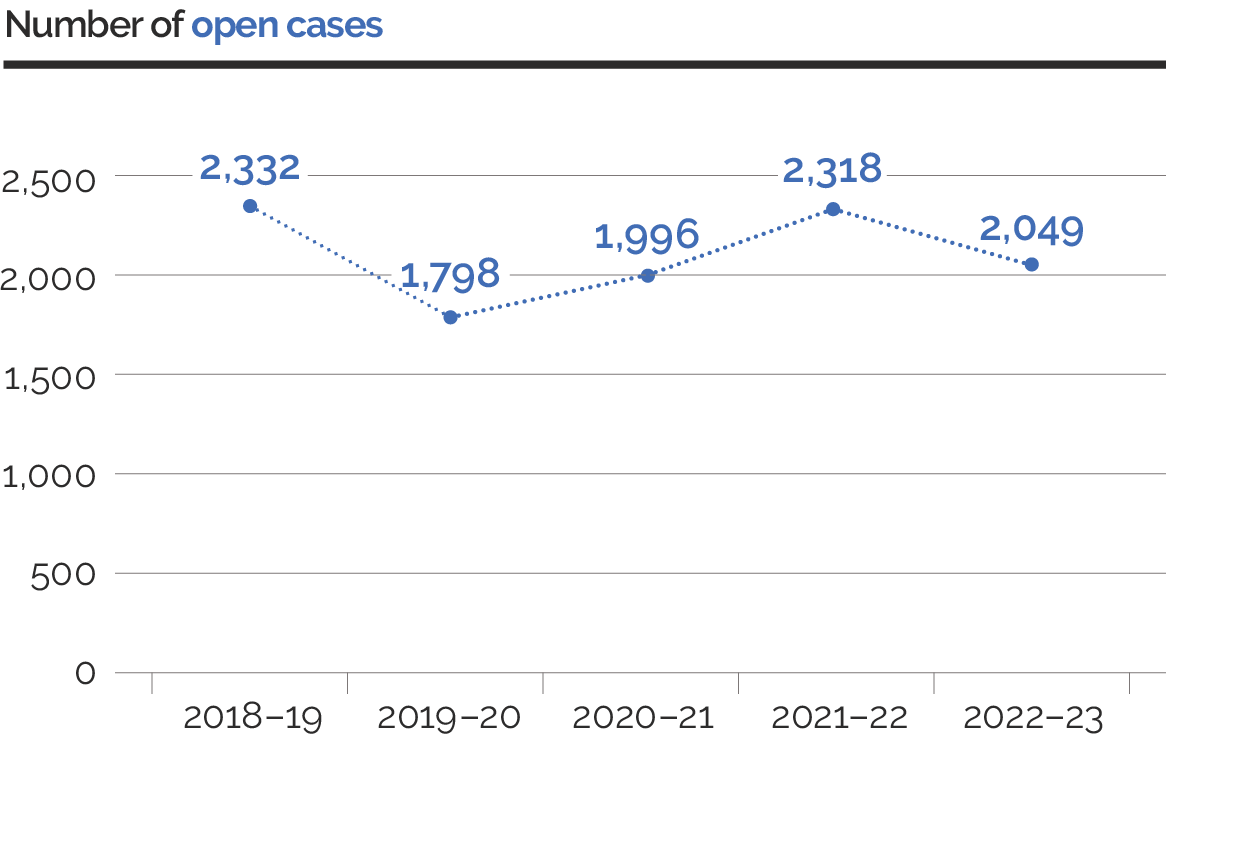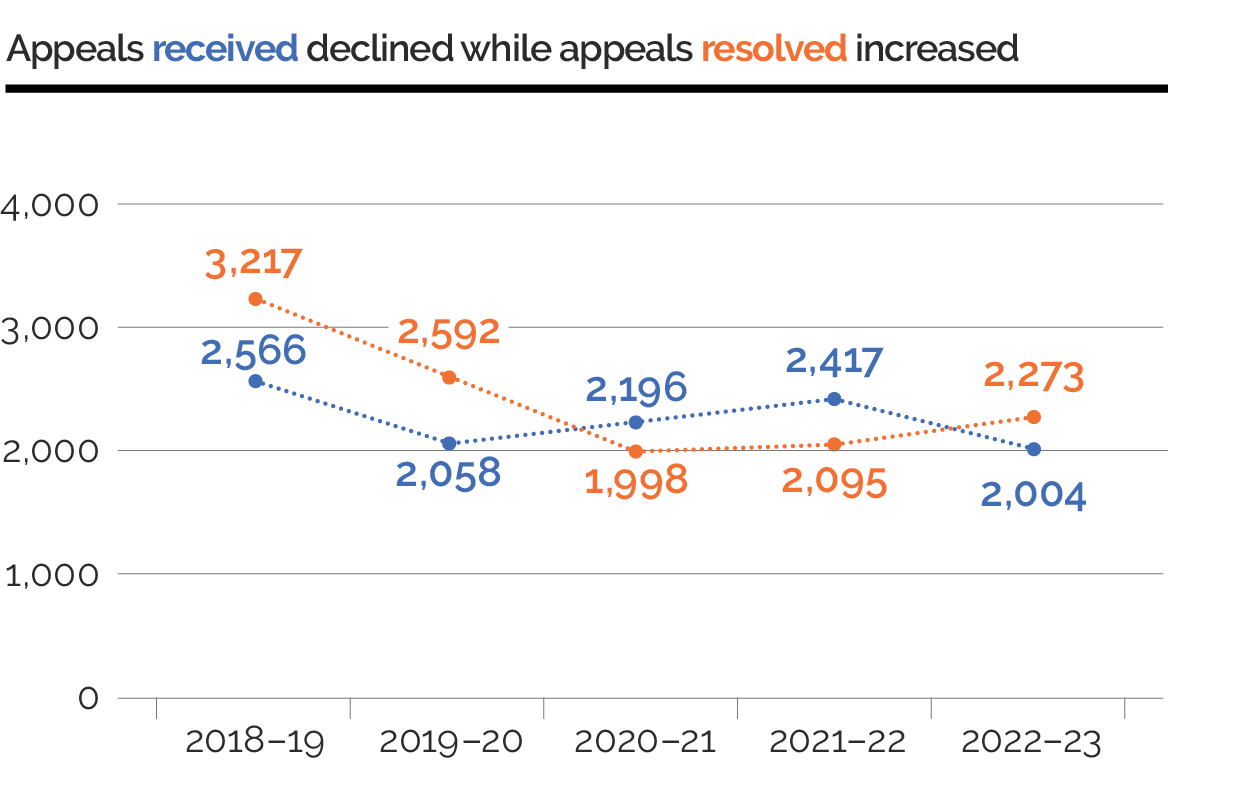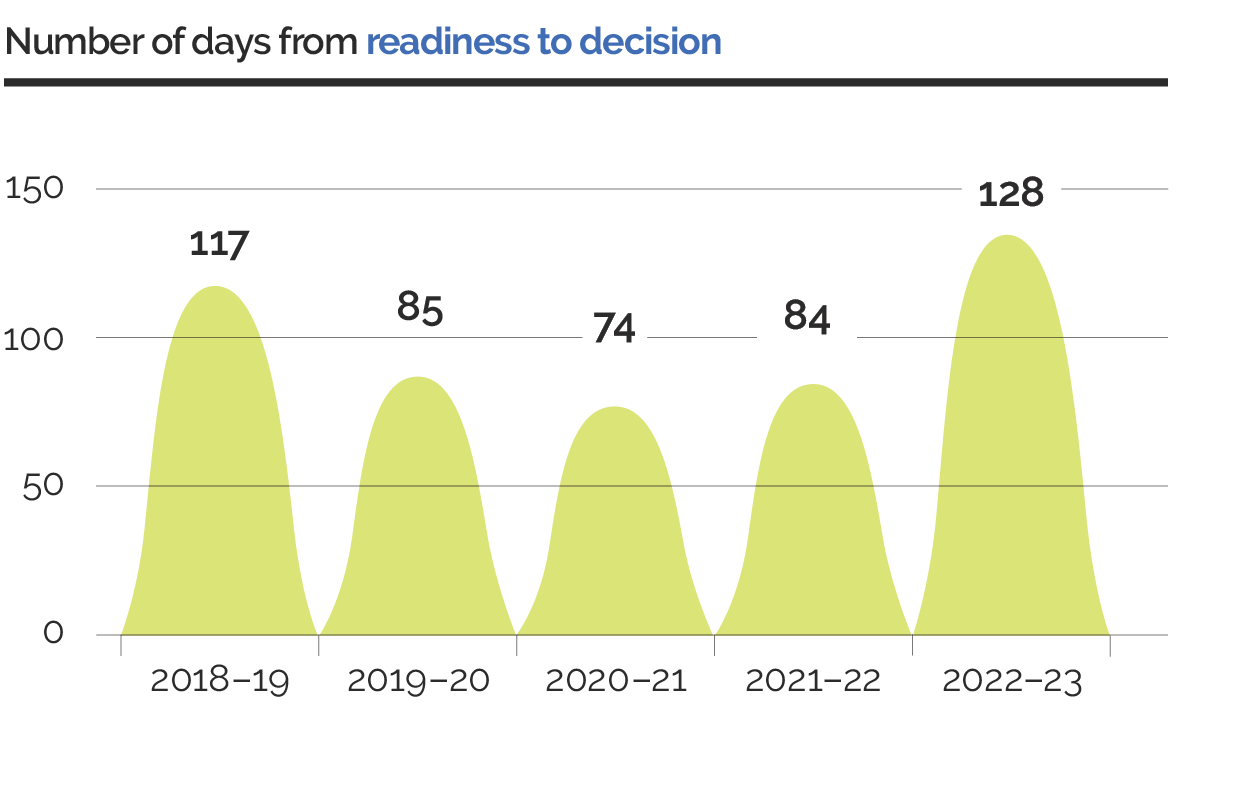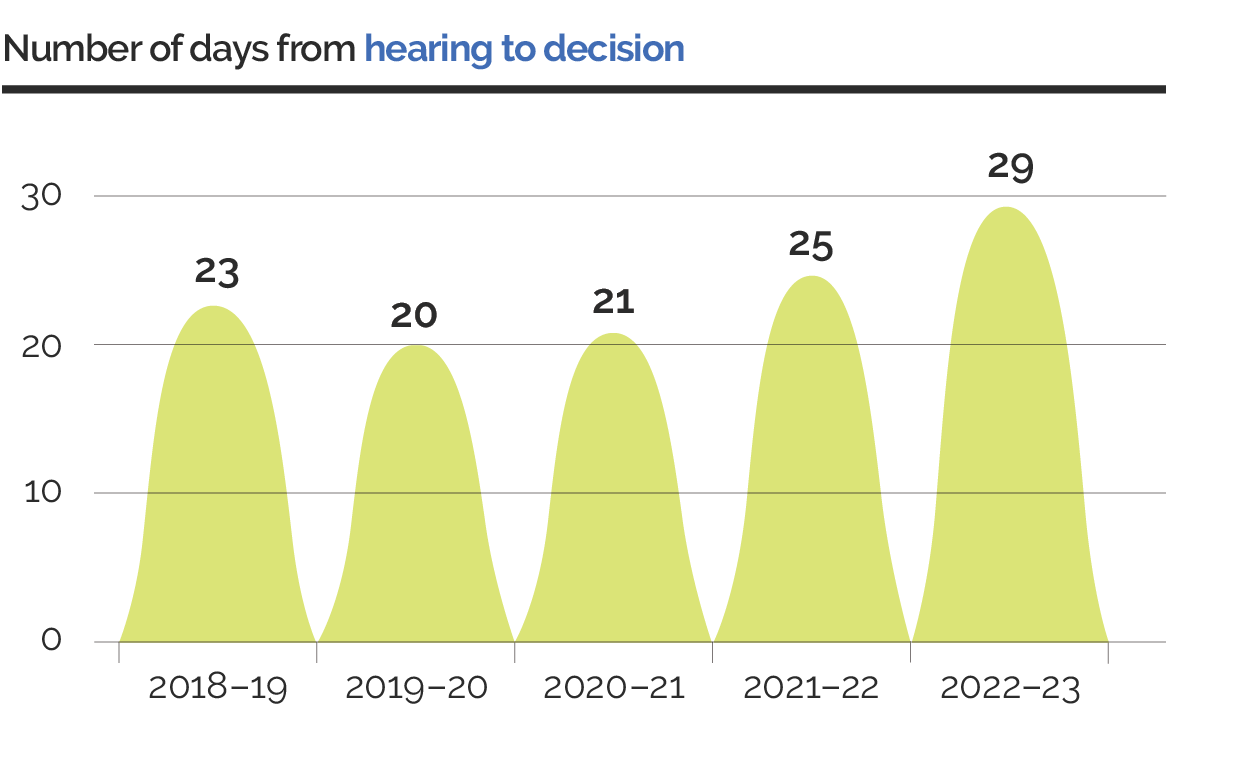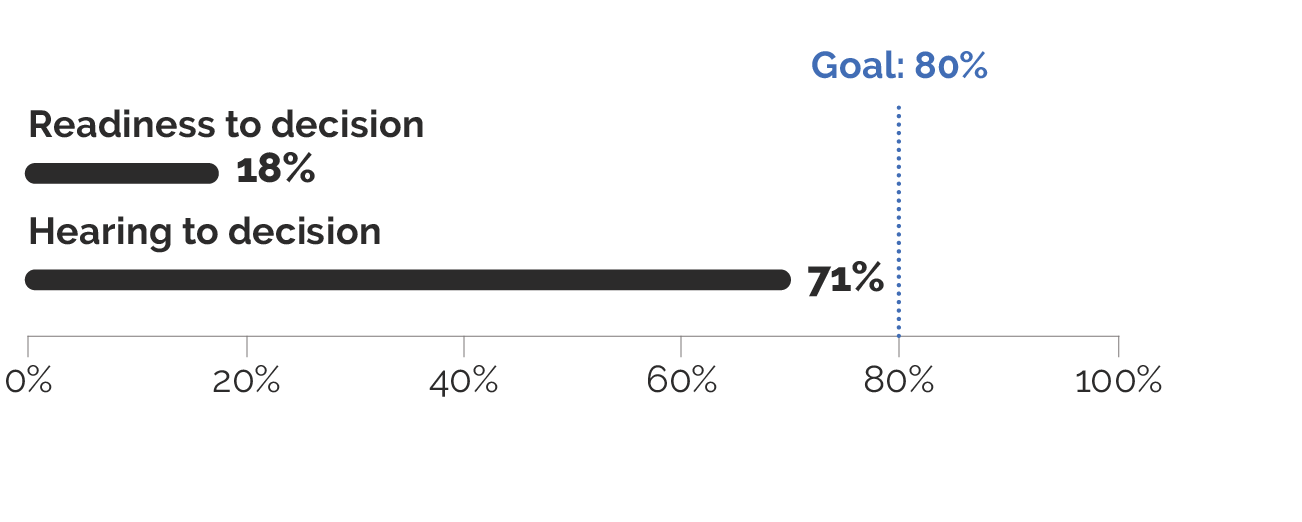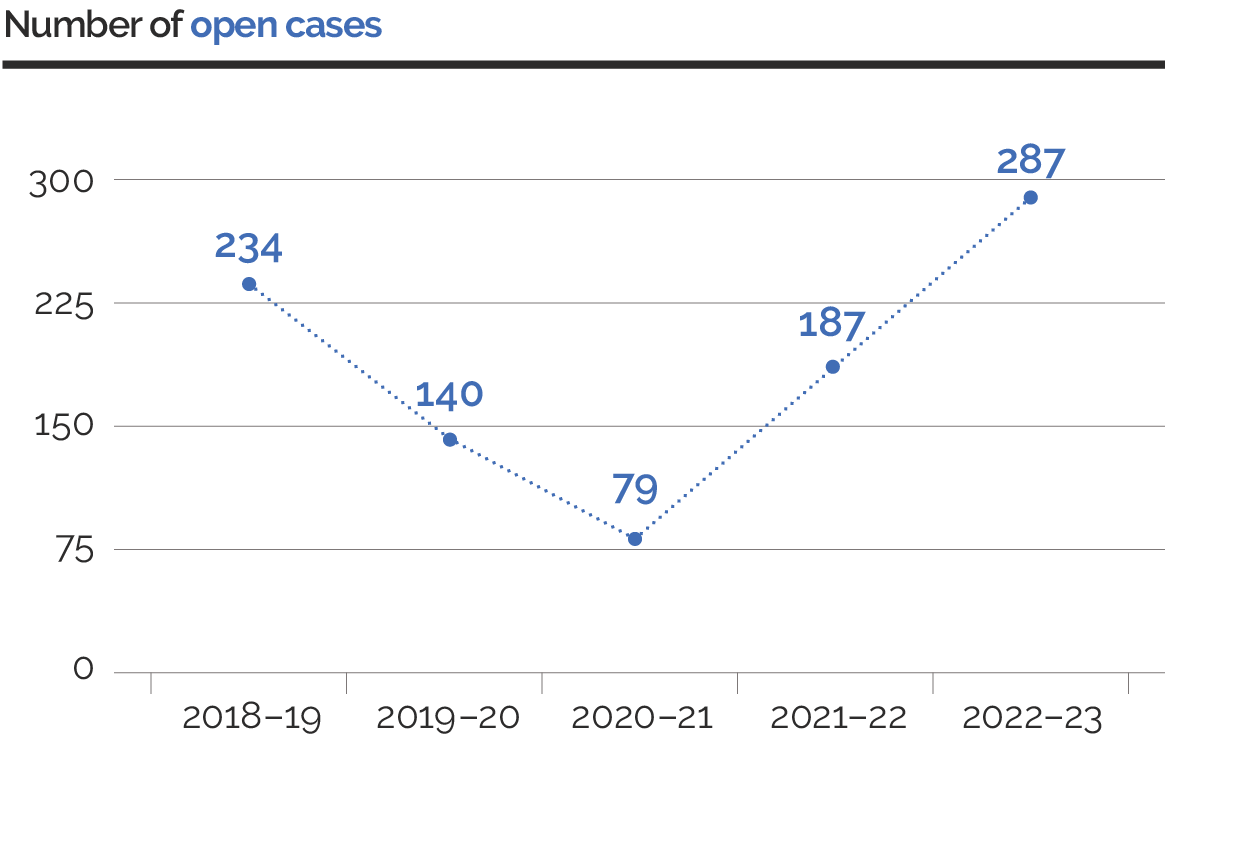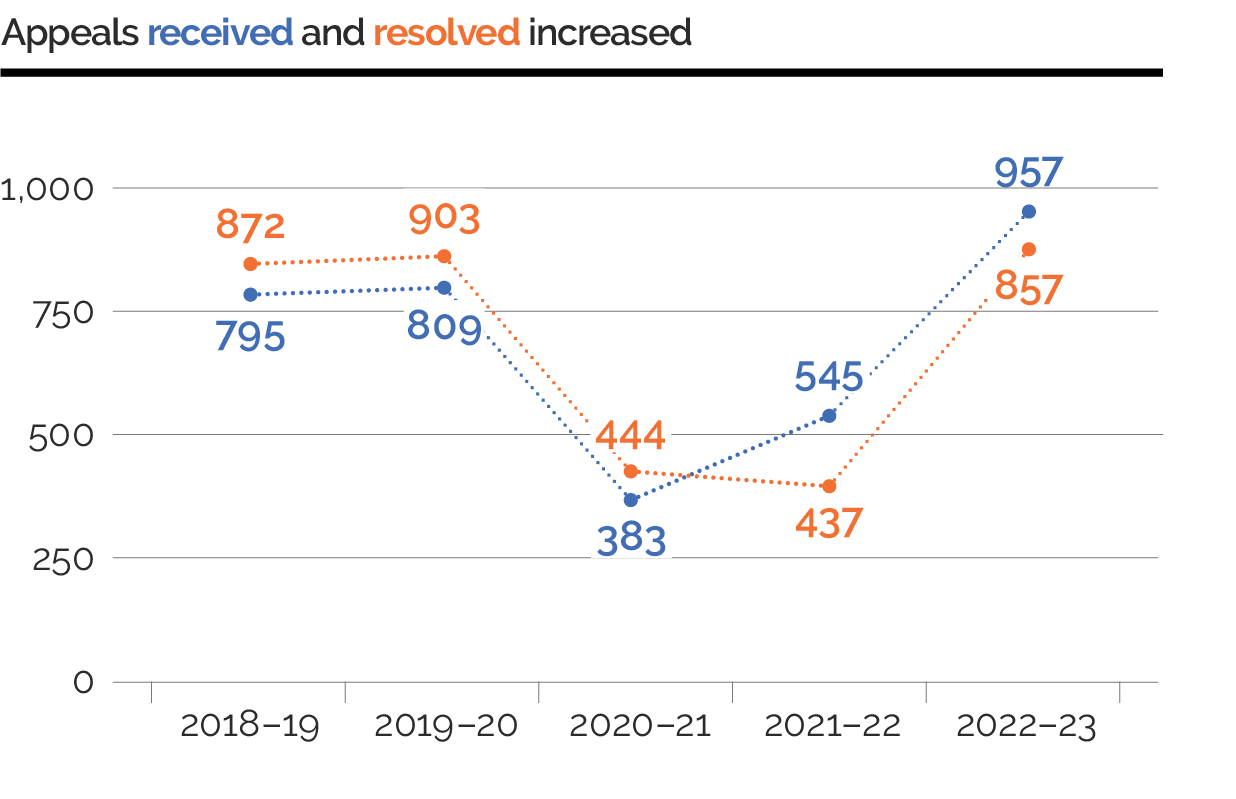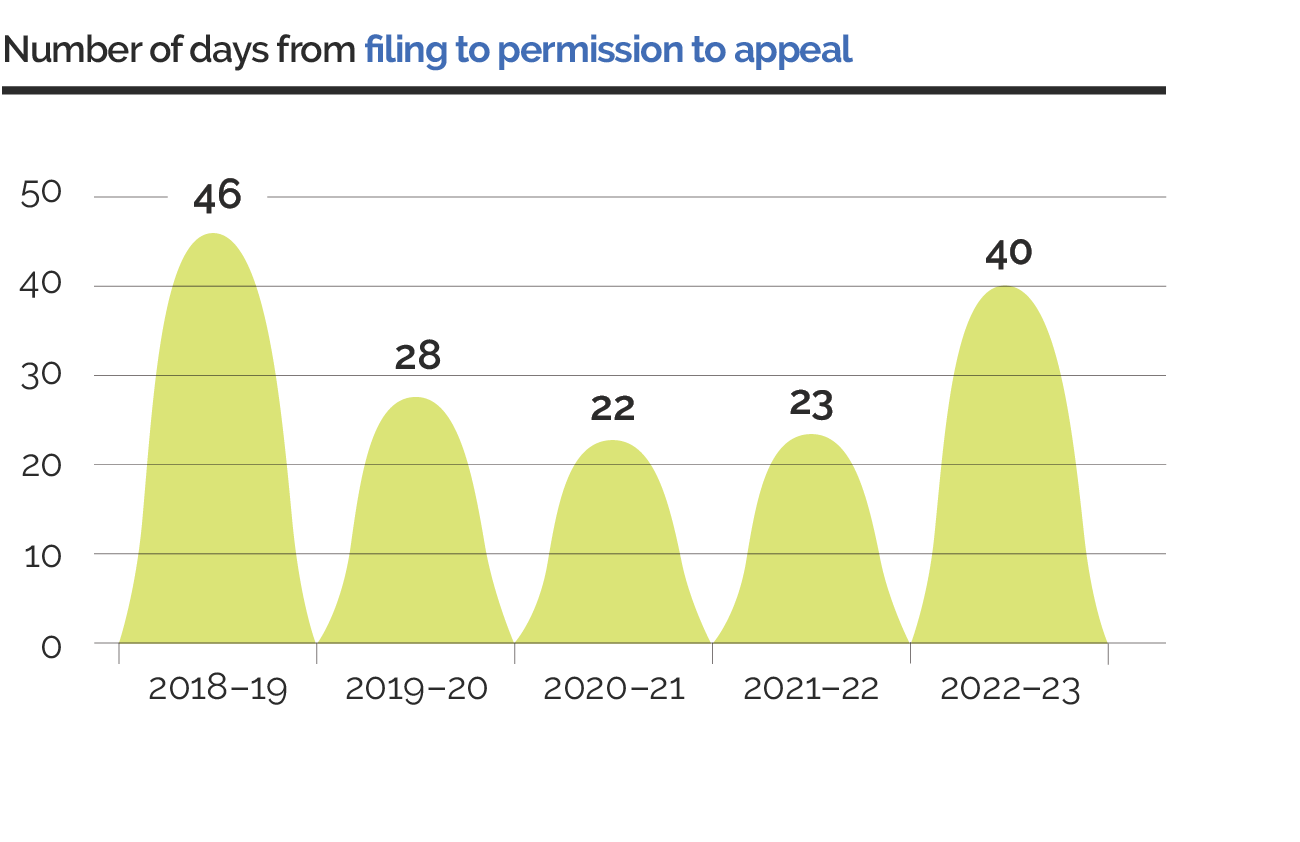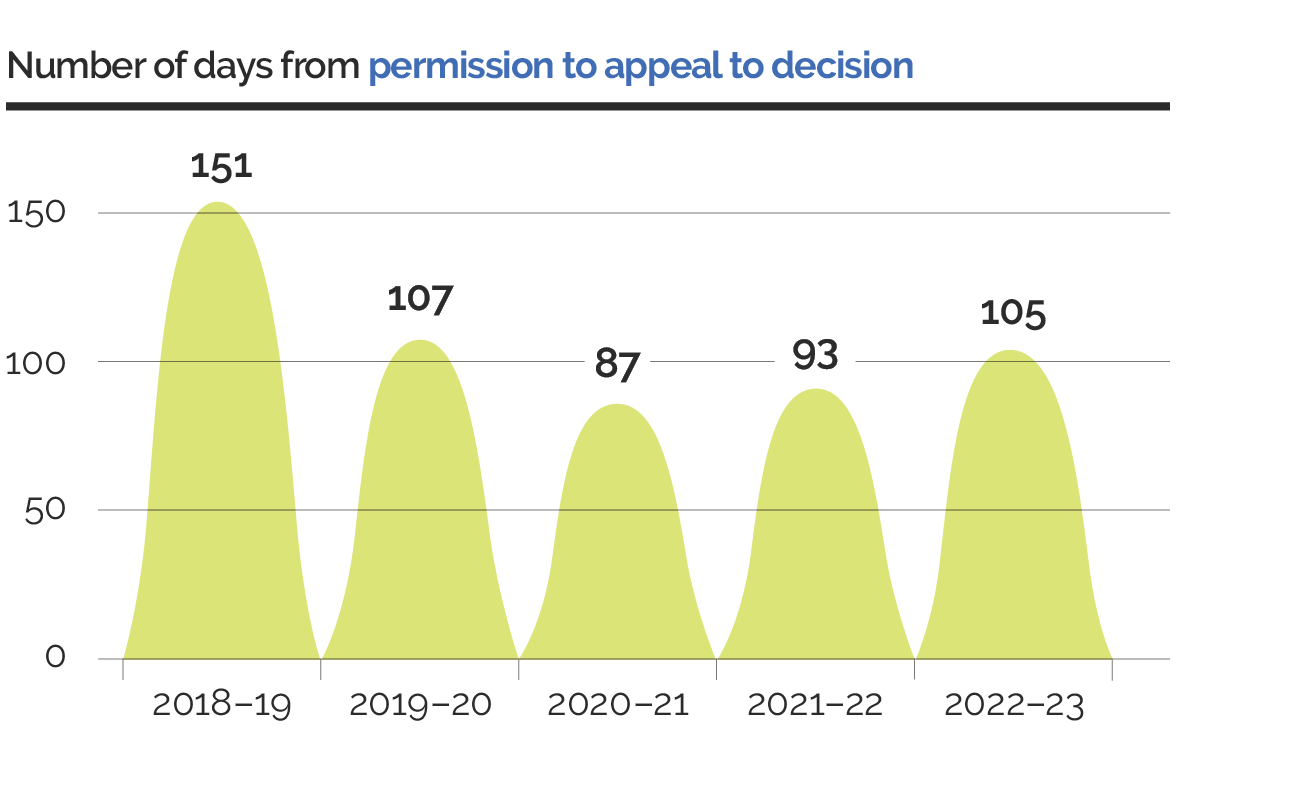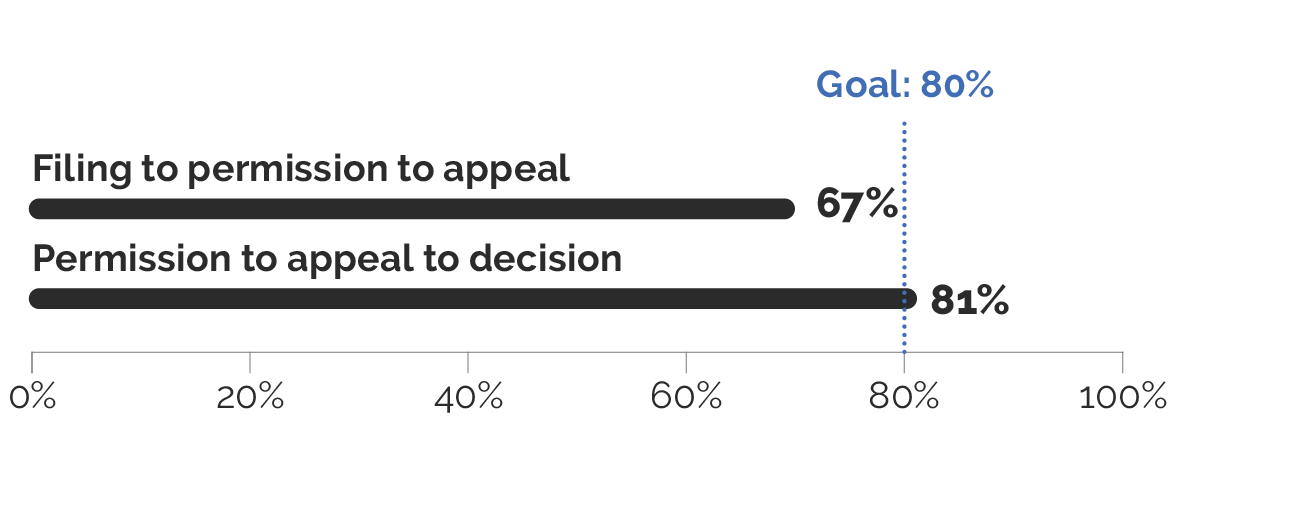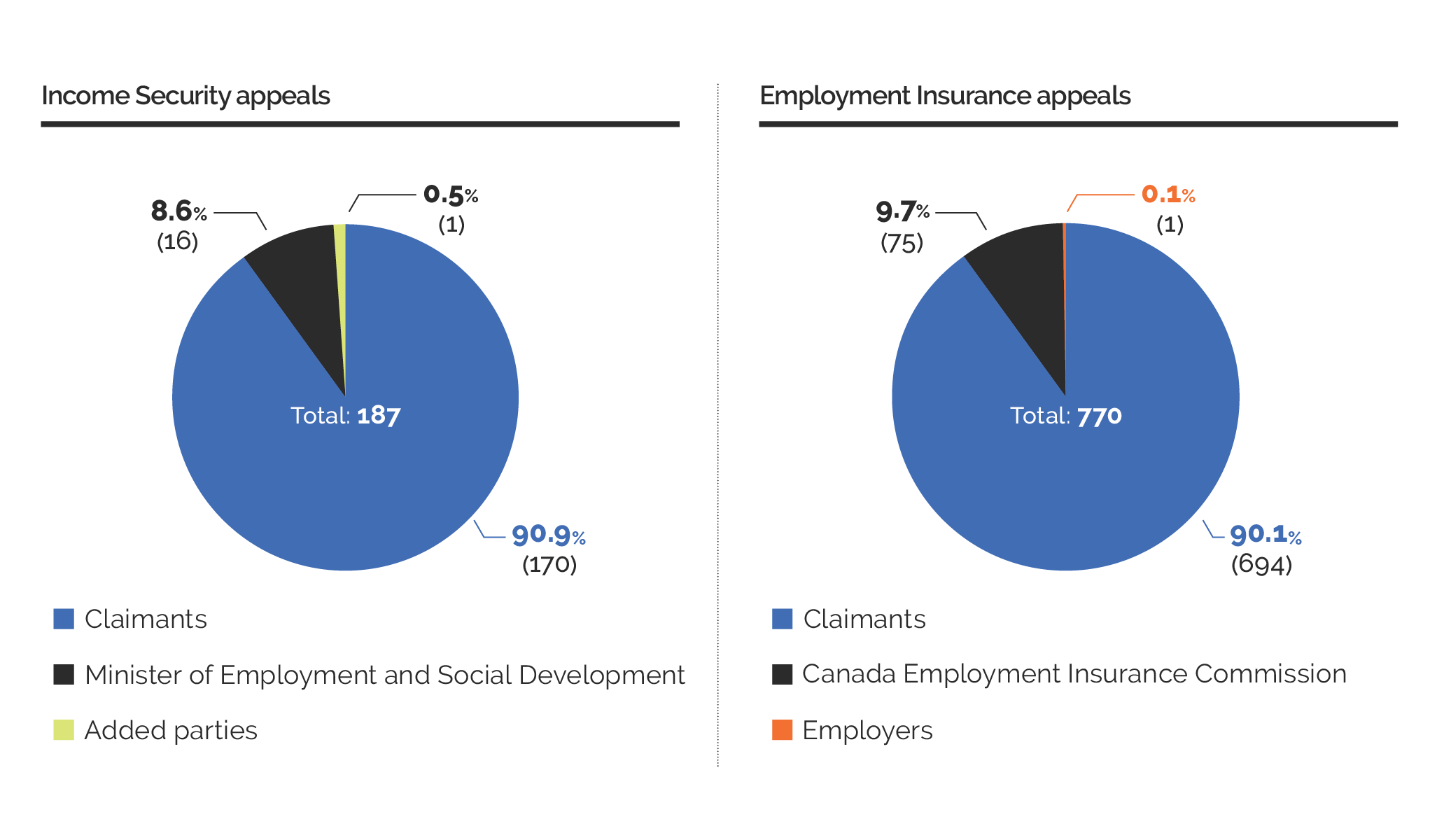Progress Report 2022-23: Next steps... the path to accessible justice
Word from the Chair and Executive Director
Next steps on the path to accessible justice
This year, the Social Security Tribunal (SST) prepared for important changes that will make our appeal process easier for people to understand and use. They include changes in the law to make the process less formal and less technical for certain types of appeals. And for all types of appeals, we now have rules of procedure written in plain language. We worked with many people to design our appeal process around the needs of those who use it.
These are the most important steps we’ve taken down the path to a more accessible justice system. But they aren’t the only ones.
- We're continuing to work on a proactive approach to case management for Canada Pension Plan and Old Age Security appeals so they can move forward as soon as parties are ready
- We're working with Community Legal Education Ontario on their online guided pathway for Canada Pension Plan disability appeal forms
- We’ve launched a survey to learn more about our appellants so we can design our process around their needs
- We’re working on writing our forms and letters with more inclusive language
This year’s progress report is divided into 2 parts. In the first part, you’ll see how we continued to put access to justice at the core of our work. In the second part, we’ll tell you about our service standards and processing times. You’ll see what’s working well and where we can do better.
Access to justice isn’t just about making it easier for people to understand how to appeal. It’s also about deciding cases quickly. Because waiting to find out whether you’re entitled to benefits is stressful. That’s something we’ll focus on in the coming year.
Paul Aterman
Chairperson
Anab Ahmed
Executive Director
What we do
The SST decides appeals about these benefits:
- Employment Insurance
- Canada Pension Plan (CPP) disability and other CPP benefits
- Old Age Security
As part of our federal social support system, these benefits are important to Canadians. People can come to the SST to challenge a government decision about their benefits.
By the numbers
Text version
We processed 6,563 appeals this year
GD-IS: 2,273; AD-IS: 178; GD-EI: 3,325; AD-EI: 787
8.6% of Appeal Division appeals have gone through Alternative Dispute Resolution (ADR)
70.4% of ADR appeals at the Appeal Division were resolved without a hearing
Navigators worked on 3,039 appeals, helping people without professional representation
We published 1,486 decisions on our website
Of the 811 survey responses we received this year, 95% of clients were satisfied overall
94% of appellants surveyed felt that we provided them with enough information about what to expect and how to prepare
97% of appellants surveyed felt they were able to participate fully in their hearings
Part 1: 2022–23 Highlights
What’s changed at the SST
We have new Rules of Procedure
The Social Security Tribunal Rules of Procedure (Rules) came into force on December 5, 2022.
After consulting widely, we designed a modern set of procedures that focus on the people who use our service. The Rules aim to help people:
- understand the appeal process
- participate fully in their appeals, with or without professional representation
- know what to expect from the SST
- know what the SST expects of them
We wrote our Rules in plain language
We wanted to write rules that the widest possible audience would understand. Why? Because most people that come to the SST:
- don’t have a legal background
- don’t have legal support
- aren’t familiar with this subject matter
Plain language is about making it easy for people to find, understand, and use the information they need. We wrote our Rules using plain language strategies. For example, we grouped the Rules by theme so people can easily find the information they need. And we broke down complicated ideas into short, separate sentences so the message is easier to understand.
We’re pleased that our partners and Justice Canada supported our efforts to use plain language in the Rules. To our knowledge, this is the first time a Canadian federal administrative tribunal has written rules of procedure in plain language.
Here’s an example of how the Rules compare to the old Social Security Tribunal Regulations. It shows how the Rules are easy to understand.
Before (Regulations)
Deemed filing dates
7 The date of filing of an appeal, application or other document is deemed to be
(a) in the case of a document that is filed at the Tribunal’s address or sent by mail or by facsimile, the date indicated by the date received stamp placed on the document by the Tribunal; and
(b) in the case of a document that is filed by email or in accordance with the Tribunal’s electronic filing procedure, the date of receipt indicated by the Tribunal’s time stamp.
After (Rules)
When a document is filed
19 (2) A document is considered filed on the date the Tribunal receives it. On each document, the Tribunal indicates the date it received the document.
We made the appeal process simpler
We changed some of our procedures to make the appeal process simpler. Here are 2 examples:
Late appeals: Giving more time
The Rules set out a simpler test for getting more time to appeal when an appeal is late. Before, the appellant had to make arguments on 4 separate factors. Now, they just have to explain why they’re late. An SST member (decision-maker) will give them more time if they have a reasonable explanation for being late.
Rescheduled hearings
Sometimes, a party needs us to reschedule a hearing. The Rules make this simpler. We now automatically reschedule if the party:
- is asking for the first time
- asks at least 5 business days before the hearing
- is available for a hearing within 2 weeks of the original hearing date
If the party doesn’t meet those conditions, they can still file a request explaining why the hearing needs to be rescheduled. We’ll reschedule if it’s necessary for a fair hearing.
We made other process changes for Income Security appeals
For Income Security appeals, we made some changes that aren’t covered in the Rules so we could keep the process as flexible as possible.
General Division
At the General Division, we actively case manage files. This means we work with parties (and their representatives) to make sure they have the time they need to make their case.
For some appeals, members are now involved early on. They may set shorter filing deadlines. They may also hold conferences to help parties better understand the appeal process. This is another way we make sure the appeal process is simple, quick, and fair. We put people at the centre of our justice service.
Appeal Division
At the Appeal Division, the law has changed:
- Appellants still need permission to appeal, but the criteria are broader
- The Appeal Division gives written reasons for granting permission to appeal only if a party asks within 10 days
- If the Appeal Division grants permission to appeal, it hears the appeal as a new proceeding
- Parties can file new evidence (including witness testimony)
- Parties don’t need to prove that the General Division made certain types of errors
- Since the Appeal Division makes a new decision, it no longer has the power to refer Income Security appeals back to the General Division
An Income Security appeal at the Appeal Division can follow 1 of 2 streams:
In the regular stream, the parties have 75 days to file their evidence. When the parties need more time to prepare or don’t need time to file documents, their appeal follows the case managed stream. This means that the member will actively manage the file to schedule simple matters quickly and give more time for complex matters.
We continued to improve our navigator service
Navigators are staff members who are specially trained to support and guide parties who don’t have a professional representative (like a lawyer). Navigators build relationships with these parties, so they feel better prepared to manage their appeals.
Last year, we talked about a report called Examining the Social Security Tribunal’s Navigator Service: Access to Administrative Justice for Marginalized Communities. We’ve been acting on the report’s recommendations. These include:
- providing training and wellness support to navigators
- using infographics to explain the appeal process
- offering interpretation services when people need them during navigation
- consulting with our partners
On average, 95% of those who completed our client satisfaction survey said they were satisfied with the help of their navigators.
Did you know?
At the SST, most claimants don’t have professional representation:
91% at the General Division – Employment Insurance
64% at the General Division – Income Security
82% at the Appeal Division
We continued to hold information sessions with community partners
This year, we expanded our legal information sessions. In addition to sessions on Employment Insurance appeals, we now offer sessions on CPP disability appeals. Law students, paralegals, community justice workers, and other advocates and representatives are all encouraged to attend.
We also offer a general information session. This 1-hour session provides an overview of the SST, the appeals process, and helpful resources that the SST offers, including the navigator service. We also offer information sessions exclusively on our navigator service.
If you’re interested in joining our community of partners or learning more about our information sessions, let us know. Contact our outreach team at:
We made our website even better
More visual content
User testing and an external report have told us the same thing: our website needed more visual content. You talked, we listened. Our website now has printable roadmaps on the processes for:
- Employment Insurance appeals
- CPP disability and other CPP appeals
- Old Age Security and Guaranteed Income Supplement appeals
We also have visual guides that explain how to prepare for a hearing. We updated their content and gave them a fresh look.
Other improvements
We made it easier for you to give feedback on our website. At the bottom of each page, you can tell us whether you found what you were looking for. This lets us know what works—and what doesn’t.
On top of that, we highlighted glossary terms throughout our website. If you hover your cursor over a term, you’ll see its definition, saving you a trip to our glossary page.
We used pilot projects and evaluations to help improve our service
Early and Active Case Management
Last year, we talked about our early resolution pilot project for the General Division – Income Security Section. This year, we started a pilot project for early and active case management. We wanted to see how we could use early intervention to support a simple, quick, and fair appeal process.
We learned that it helps to involve a member early on for some appeals, including:
- Old Age Security appeals
- CPP (other than disability) appeals
- appeals with issues we don’t have the power to decide
It’s different for CPP disability appeals because appellants generally need time to gather and submit evidence.
We’ll keep looking at how we can effectively case manage appeals and apply lessons learned from the project.
Document lists
Some people told us that they have trouble managing the documents for their appeal. We send them a lot of documents at different times. So, in December 2022, we started a pilot project at the Appeal Division to see whether we could help with this.
We now give parties a list of relevant file documents shortly before the hearing so they can better prepare. And we plan to do the same at the General Division.
Plain language decisions
The laws we work with can be hard to read, but our decisions don’t have to be. We’ve been working hard to make them easier to understand. This year, we evaluated how accessible they are. We analyzed decision texts and talked to:
- people who had represented themselves
- third-party experts in plain language
- members
The results show that our decisions are easier to read, but they could still be better. For example, people said that we should make the result of the appeal clearer and clearly state what the next steps are. Read more about the evaluation and our action plan on our website.
Gender-based Analysis Plus (GBA+) survey
The SST serves people from diverse backgrounds and with different needs. To better understand their socio-demographic profile, we launched a GBA+ survey in December 2022.
The survey is voluntary and anonymous. It will help us find and address barriers in our processes and improve access for the people we serve.
Did you know?
During The Action Group on Access to Justice's A2J Week in October 2022, the SST shared its experience on its innovations to break down barriers to justice and practical ways to measure and evaluate access to justice.
What we’re doing next
We keep looking for ways to serve you better. We do this by listening to our partners and to the people who use our service. The feedback we get helps us make the right changes. One of our top priorities is to make our appeal process inclusive and accessible. We want to create an environment where all participants can understand and participate fully in the appeal process.
Here’s a look at some of our upcoming projects:
- We'll start adding video content to our website to give people another way to get the information they need
- At the General Division, we’ll let people use their My Service Canada Account (MSCA) to file their Income Security appeals, including their supporting documents
- We’re working with Community Legal Education Ontario to make an online guided pathway for people applying for CPP disability.
- The pathway guides them through filling out their notice of appeal form
- When they’re done, the pathway generates a completed form that they can submit to the SST
- Look for the pathway! (It should be ready by July 2023)
- We’ll continue efforts to meet our commitment to equity, diversity, and inclusion, which will include:
- consulting with partners to update our Accessibility and Accommodation Policy
- working with a diversity consultant to look at how we can use more inclusive language in our decisions and letters
- updating the Notice of Appeal form so that appellants can identify their pronouns
We look forward to updating our partners and the public as these important initiatives take shape.
Part 2: Results
Our goal is to make quality decisions as quickly as possible without compromising fairness. This year, we fell below where we’d like to be.
Across the SST, we didn’t have enough members to deal with all our appeals. Gaps in reappointments in 2021 and early 2022 meant that we started the fiscal year with a backlog of appeals at the General Division and the Appeal Division. A large increase in Employment Insurance appeals meant that the backlog of appeals at the General Division – Employment Insurance Section and the Appeal Division grew as the year went on.
It was difficult to meet service standards even for newer appeals because we had to assign the older ones first. In many cases, the service standard had passed before the member even got the file.
Before we can get back to meeting our service standards for timely decisions, we have to tackle our backlog of appeals. Here’s what we’ve done so far.
We added new members
Recruiting, appointing, and training new members takes many months. We welcomed 25 new members to the SST. We moved members from the General Division to the Appeal Division, and we reassigned members between the 2 sections of the General Division.
Overall, we increased our capacity from 46 full-time equivalent members at the beginning of the fiscal year to 65 full-time equivalent members at the end. And we’re working to bring another group of new members on board in the spring of 2023.
We found ways to speed things up
We took other steps to make decisions faster. We:
- focused on improving internal processes
- introduced early and active case management for General Division – Income Security appeals
- continued with alternative dispute resolution (ADR) at the Appeal Division
With these efforts, we expect to reduce or eliminate our backlog of appeals in the 2023–24 fiscal year. This will bring us closer to meeting our service standards across the SST.
Despite not meeting our service standards, we didn’t see a change in our client service feedback. Overall satisfaction with our service was 96%.
Here are the numbers
General Division - Employment Insurance
Employment Insurance (excludes group appeals)
Inventory by fiscal year as of March 31
Text version
Graph showing the inventory for the number of open cases from 2018-19 to 2022-23 has increased. There were 667 open appeals at the end of 2018-19. 502 open appeals at the end of 2019-20. 266 open appeals at the end of 2020-21. 845 open appeals at the end of 2021-22. 1,618 open appeals at the end of 2022-23.
Text version
Graph showing the inventory for General Division – Employment Insurance appeals (excluding group appeals). Appeals received increased faster than appeals resolved last year. In 2018-19, 3,473 appeals were received, and 4,902 appeals were resolved. In 2019-20, 3,814 appeals were received, and 3,979 appeals were resolved. In 2020-21, 1,669 appeals were received, and 1,905 appeals were resolved. In 2021-22, 3,138 appeals were received, and 2,559 appeals were resolved. From 2022-23, 3,970 appeals were received, and 3,197 appeals were resolved.
Processing times by fiscal year as of March 31
In 2022–23, our average time from filing to decision was 113 days and from hearing to decision was 19 days.
Text version
Graph showing the average number of days from filing to decision from 2018-19 to 2022-23, which increased last year. The processing times are as follows: 144 days in 2018-19. 51 days in 2019-20. 37 days in 2020-21. 43 days in 2021-22. 113 days in 2022-23.
Text version
Graph showing the average number of days from hearing to decision from 2018-19 to 2022-23. Last year, the number of days from hearing to decision increased. The average processing times are as follows: 23 days in 2018-19. 14 days in 2019-20. 9 days in 2020-21. 10 days in 2021-22. 19 days in 2022-23.
Service standards
This year, we wanted to give appellants their decisions within 45 days of when they filed their appeals and within 15 days of their hearings. We wanted to do this at least 80% of the time.
Text version
Graph showing that we fell short in meeting our service standards. We met our service standard 7% of the time from filing to decision and 61% of the time from hearing to decision. Our goal for both service standards was 80%.
Appeal origin
Most appeals at the General Division came from claimants.
Text version
Pie chart showing who filed the appeal at the General Division – Employment Insurance section: 99.2% of appeals, which amounted to 3,937 appeals, were from claimants, and 0.8% of appeals, which amounted to 31 appeals were from employers. The total number of appeals filed at the General Division – Employment Insurance section was 3,968.
General Division - Income Security
Inventory by fiscal year as of March 31
Text version
Graph showing the inventory for the number of open cases from 2018-19 to 2022-23, which decreased last year. There were 2,332 open appeals at the end of 2018-19. 1,798 open appeals at the end of 2019-20. 1,996 open appeals at the end of 2020-21. 2,318 open appeals at the end of 2021-22. 2,049 open appeals at the end of 2022-23.
Text version
Graph showing the number of appeals received and the number of appeals resolved for the General Division – Income Security from 2018-19 to 2022-23. There was a decline in appeals received in 2022-23 compared to the previous fiscal year. In 2022-23, there was an increase in appeals resolved compared to 2020-21 and 2021-22. In 2018-19, 2,566 appeals were received while 3,217 were resolved. In 2019-20, 2,058 appeals were received while 2,592 were resolved. During 2020-21, 2,196 appeals were received while 1,998 were resolved. During 2021-22, 2,417 appeals were received while 2,095 were resolved. In 2022-23, 2,004 appeals were received while 2,273 were resolved.
Processing times by fiscal year as of March 31
This year, our average time was 128 days from readiness to decision and 29 days from hearing to decision.
Text version
Graph showing the average number of days from readiness to decision from 2018-19 to 2022-23, which increased last year. The average processing times are as follows: 117 days in 2018-19. 85 days in 2019-20. 74 days in 2020-21. 84 days 2021-22. 128 days in 2022-23.
Text version
Graph showing the average number of days from hearing to decision, which is generally increasing from 2018-19 to 2022-23. The processing times are as follows: 23 days from 2018-19. 20 days from 2019-20. 21 days from 2020-21. 25 days from 2021-22. 29 days from 2022-23.
Service standards
This year, we wanted to give appellants their decisions within 70 days of when parties were ready for the hearing and within 30 days of the hearing. We wanted to do this at least 80% of the time.
Text version
Graph showing that we fell short in meeting our service standards. We met our readiness to decision service standard 18% of the time and our hearing to decision service standard 71% of the time. Our goal for both service standards was 80%.
Appeal Division - (excludes Employment Insurance group appeals)
Inventory by fiscal year as of March 31
Text version
Graph showing the inventory for the number of open cases from 2018-19 to 2022-23. The number of open cases has increased over the last 2 years. There were 234 open appeals at the end of 2018-19. 140 open appeals at the end of 2019-20. 79 open appeals at the end of 2020-21. 187 open appeals at the end of 2021-22. 287 open appeals at the end of 2022-23
Text version
Graph showing the number of appeals received and the number of appeals resolved for the Appeals Division (excluding group appeals). Appeals received and resolved increased during the time period from 2018-19 to 2022-23. In 2018-19, 795 appeals were received, and 872 appeals were resolved. In 2019-20, 809 appeals were received, and 903 appeals were resolved. In 2020-21, 383 appeals were received, and 444 appeals were resolved. In 2021-22, 545 appeals were received, and 437 appeals were resolved. In 2022-23, 957 appeals were received, and 857 appeals were resolved. For each of the last 5 fiscal years, there were more appeals resolved than received, except for 2021-22 and 2022-23.
Processing times by fiscal year as of March 31
The process for Income Security appeals at the Appeal Division changed on December 5, 2022. The numbers below include Income Security appeals up to December 5, 2022, and all Employment Insurance appeals. This year, our average time to give permission or leave to appeal was 40 days. Our average time to make a final decision was 105 days.
Text version
Graph showing the average number of days from filing to permission to appeal from 2018-19 to 2022-23, which increased last year. The processing times are as follows: 46 days in 2018-19. 28 days in 2019-20. 22 days in 2020-21. 23 days in 2021-22. 40 days in 2022-23.
Text version
Graph showing the average number of days from permission to appeal to decision from 2018-19 to 2022-23, which has been gradually increasing during the last 2 years. The processing times are as follows: 151 days in 2018-19. 107 days in 2019-20. 87 days in 2020-21. 93 days in 2021-22. 105 days in 2022-23.
Service standards
We wanted to give appellants their decisions about permission to appeal within 45 days of when they filed their appeals. And we wanted to make a final decision within 150 days of giving permission to appeal. We wanted to do both of these things at least 80% of the time.
Text version
Graph showing that we fell short in meeting our service standard on filing to permission or leave to appeal . We met our filing to permission to appeal service standard 67% of the time. Graph also shows that we met our permission to appeal to decision service standard 81% of the time. Our goal for both service standards was 80%.
Alternative Dispute Resolution (ADR) at the Appeal Division
The Appeal Division brings parties together for ADR when they may be able to resolve the appeal without a hearing. This year, 9% of Appeal Division cases went through the ADR process. Of those cases, 70% were resolved with ADR.
Appeal Origin
Most appeals at the Appeal Division are launched by claimants, not the Minister or Commission.
Text version
Pie chart showing who filed the appeal at the Appeal Division – Income Security section: 90.9% of appeals, which amounted to 170 appeals, were from claimants. 8.6% of appeals, which amounted to 16 appeals, came from the Minister of Employment and Social Development. 0.5% which amounted to 1 of appeal came from added parties. The total number of appeals filed at the Appeal Division – Income Security section was 187.
Pie chart showing who filed the appeal at the Appeal Division – Employment Insurance section: 90.1% of appeals, which amounted to 694 appeals, were from claimants. 9.7% of appeals, which amounted to 75 appeals, came from the Canada Employment Insurance Commission. 0.1% which amounted to 1 appeal came from employers. The total number of appeals filed at the Appeal Division – Employment Insurance section was 770.
Note: The percentages in these charts may not add up to 100% due to rounding to the nearest tenth of a percentage point.











